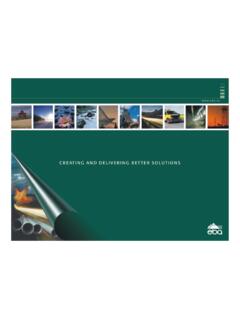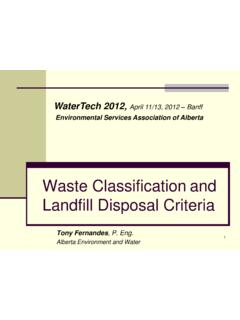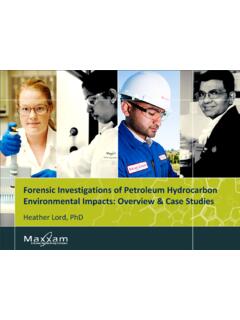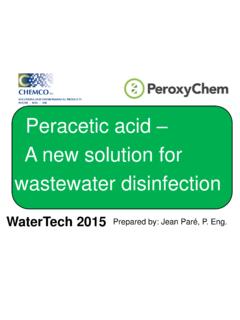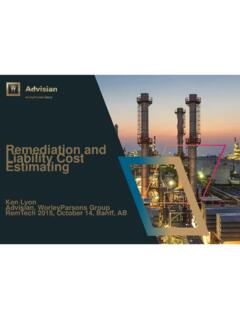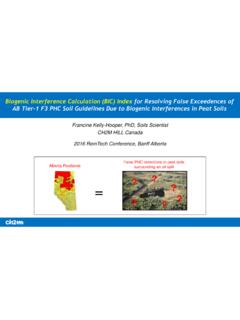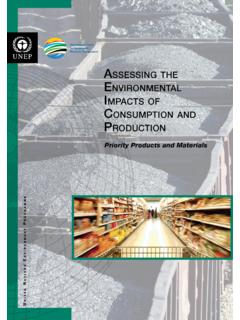Transcription of What do Total and Dissolved Metal Concentrations …
1 What do Total and Dissolved Metal Concentrations in groundwater Samples Really Tell Us? Part 1: Metal Speciation, Analytical Definition and Toxicity Elizabeth Haack, , WaterTech 2013, April 11 2013, Banff, AB. Contemplated Policy AESRD 2 Wallace (2012) Unfiltered, Field Acidified Filtered m filter, Field Acidified Note: Best way to sample metals in water is a source of ongoing debate globally (US, European Union) Will we necessarily obtain meaningful and scientifically-defensible data using this approach? Exceedingly difficult question to answer based on the sampling objectives, being: Meaningful Data To determine whether or not specific anthropogenic activities are affecting natural levels?
2 To predict potential adverse health effects to receptors at the point of exposure. Human ingestion (and dermal exposure) treatment? Shallow groundwater (eco direct contact) Discharge point to surface water body conditions along flow path? Overarching Challenge: Operational Definition Absolute Total Concentration of a Metal Dissolved Passes through m filter Trully Dissolved (< 1 nm: Hydrated ions, Low Molecular Weight Fraction) Colloidal ( m - 1 m); Guo and Santschi 2007 Particulate/Suspended Retained by M filter Field Acidification Strong Acid Extractable Nitric/Hydrochloric Acid Digestion (USEPA, 2010) Very Strong acids (solubilize metals from crystal structure) Metals are associated with matter (ligands, colloids, particles) that spans a continuum of sizes will be partitioned amongst all fractions in accordance with properties of both Metal and matter Not static perturbation of conditions will affect partitioning A Metal /trace element s mobility, bioavailability and toxicity is almost always dependent on its speciation.
3 Speciation involves a myriad of considerations: oxidation state / redox conditions presence and activity of microbes solubility of mineral phases ligands reactions at the solid-solution interface presence of other metals/ions Overarching Challenge - Speciation Ken s Talk - Next Rigorous science requires that the following a true: methods obtain representative samples of the relevant fractions. is a good understanding of what the relevant forms (chemical species) of the Metal will be. methods exist that can accurately quantify Total metals as well as relevant species Concentrations data exists that allows us to assess the (relative) bioavailability and toxicity of all forms.
4 To meet Example: Chromium Why Chromium? Growing concern over Cr(VI) carcinogenicity by oral exposure route State of California: groundwater Ambient Monitoring and Assessment (GAMA) Program (2011) >47 % of wells tested, Cr(VI) exceeded the detection limit for the purposes of reporting of 1 /L (1 ppb) Public Health Goal of 20 ng/L (20 ppt) published in 2011 (OEHHA) Science behind existing Total Cr criteria (50 ppb, Canada) outdated US EPA currently considering a Maximum Concentration Limit for Cr(VI alone). 1. Do we understand the relevant forms? Present naturally in groundwater through weathering of Cr-containing soils and rocks (secondary minerals, chromic oxide, chromite) electroplating factories, leather tanneries and textile manufacturing facilities Aqueous Speciation: Cr(III) (cationic) and Cr(VI) (anionic) Cr (III) to Cr (VI): Mn oxides and bacterial oxidation, kinetics slow Not the whole story - mixed species -Non-equilibrium conditions -Complexes with OM McNeill et al.
5 , 2006 From McNeill et al. 2012, 4 mg/L Fe(OH)3, 5 g/L Cr(III) or Cr(VI 1. What are the relevant forms that are not trully Dissolved Previous slides indicate that both in filtered and non-filtered samples, may have a complex combination of species Total Cr by ICP-MS No speciation Prone to interferences (ArC, ClO) Stong acid digest may not be effective (Kumar and Riyazuddin 2009) Detection limits are not in line with levels proposed for Cr(VI) (~ g/L) Speciation Analysis - Cr(VI) by Ion Chromatography (McNeill et al., 2012) New methodologies (US EPA Method ) mean that laboratories are capable of detection limits required for ppt-level criteria and does not require filtration (Ask your commercial lab) May be some issues with respect to contamination of Cr(VI) with reagents used to adjust pH Field filtration may not be necessary 2.)
6 Can we analyze Total and all the species Concentrations ? 3. So what? What is important to my receptor? Hexaaquachromium ion; not actively transported Cr in soils/particulates (largely Cr) does not appear to be bioavailable through leaching tests that simulates stomach and intestinal environment Similarity of the Cr(VI) ion to sulphate readily taken up Mammal Studies indicate mutagenic effects Hold up on regulatory criteria: BIOAVAILABILITY OF Cr(VI) critical factor linking aqueous phase concentration to the toxic dose -Cr(VI) reduced to Cr(III) in saliva and tract - Amount not reduced unknown Zhitkovich, 2011 Speciation, analytical and toxicology are all somewhat understood Studies suggest that risks overwhelmingly related to Cr(VI) in samples Proposed approach ( Total vs.)
7 Dissolved ) is not likely to significantly increase our understanding of risks Interim reasonable because of unknown potential for Cr(III) oxidation Summary - Cr Other Metals Simpler Biogeochemistry - predominantly present in groundwater as divalent cations behaviour largely sorption-controlled, or complexation with organic ligands: Cu(II) Cd(II) Zn(II) Ni(II) Co(II) Complex Biogeochemistry that includes consideration of bioaacumulation and potential biomagnification Selenium and Mercury Studies have not shown that water Concentrations are not a good predictor of risk to higher-level organisms. Ecological Tissue-based criteria Other Metals/Trace Elements Thermodynamic Equilibirum models (Biotic Ligand Model; WHAM) can be used with water quality data to evaluate/predict available Concentrations Emerging/Applied Methods Bioanalogical Sensors (Van Leeuwen et al.
8 2005): Diffusive Gradient Thin Films Gel-Integrated Microelectrodes Permeation Liquid Membrane Voltammetry Bioavailability to specific organisms: Biosensors/Bioluminescence Sensors - (Ivask et al. 2009) Wholeistic: In Situ effects monitoring caged test species Toxicology Omics Sciences: Revolutionizing toxicology (Cohen 2004; North and Vulpe 2010) Cheaper, faster, number of endpoints less limited than trad. animal testing Can test mixed systems ( where more than one contaminant is present) Approaches to Consider Time-averaged, preconcentration - Mobile and Labile forms Operationally Defined; Not all elements Sensitivity and Specificity may not be sufficient Quality Control and Standards Lacking Significant technical expertise to use/deploy and interpret Difficulty in assessing the meaningfulness of data from the proposed approach is in line with ongoing debate globally ( responses to the Dissolved -phase decision as part of the Water Framework Directive of the European Union) Approach is arbitrary, and considered here to be an interim approach based on current science.
9 In the short term, from the standpoint of the realities of monitoring wells, system complexity, analytical constraints, and the varied receptors to be accounted foremost in decision-making around metals sampling should be sound professional judgment and interpretation based on understanding of biogeochemistry and potential risks. In the medium-long term - a new paradigm whereby effects monitoring, monitoring of specific high-risk species , or evaluation of tissue-based Concentrations (for some elements) to emerge that provides a lines-of-evidence approach to risks from Metal /trace element Concentrations at a Site. Concluding Thoughts Thank You Questions?
10 Elizabeth Haack WorleyParsons Canada Services Ltd. 905-614-2844 Cohen, S. 2004. Risk Assessment in the Genomic Era. Toxicologic Pathology. 32, 3. Eaton, A., Ramirez, and Haghani, A., 2001. The Erin Brokovich Factor Analysis of Total and Hexavalent Chromium in Drinking Waters. AWWA Water Quality Technology Conference, Nashville, TN. groundwater Ambient Monitoring and Assessment (GAMA) Program . groundwater Information Sheet: Hexavalent Chromium. Guo, L., and Santschi, , 2007. Ultrafiltration and its applications to sampling and characterisation of aquatic colloids. Environmental Colloids and Particles: Behaviour, Separation and Characterisation.
